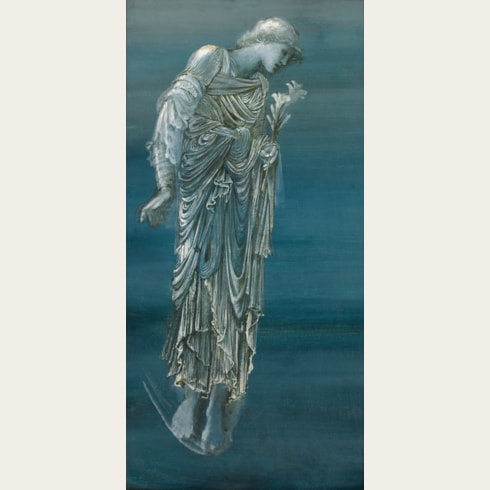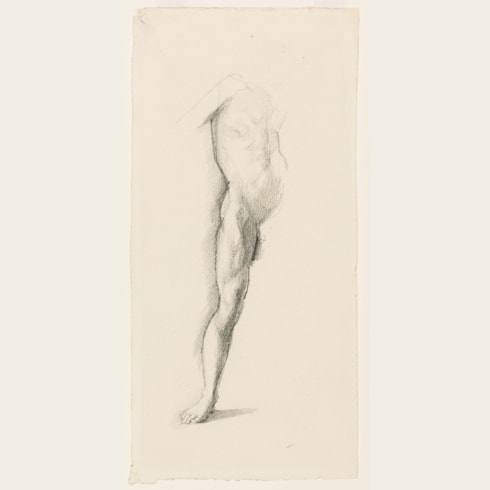Edward Coley BURNE-JONES
(Birmingham 1833 - London 1898)
Studies for The Garden of Pan: The Head and Torso of a Male Nude and Two Studies of Arms
360 x 237 mm. (14 1/8 x 9 3/8 in.)
As Burne-Jones’s wife describes the origins of the painting in her biography of the artist, the concept had taken root several years earlier, with the artist planning a seemingly much more complex composition: ‘In 1872 he wrote down the names of four other subjects, saying: “These I desire to paint above all others.” Nor was this an aspiration only, for at the time he wrote they were all begun in one form or another...[including] “a picture of the beginning of the world, with Pan and Echo and sylvan gods, and a forest full of centaurs, and wild background of woods, mountains, and rivers.”’
At some point the artist seems to have realized that such a complex painting would be difficult to accomplish, and the composition of the picture was eventually modified to depict just three figures. Its title, too, was eventually changed, as Georgiana Burne-Jones writes, ‘“The Garden of Pan”, exhibited at the Grosvenor Gallery in 1887, is a fulfilment of part of Edward’s intention to paint the Beginning of the World. He first called it “The Youth of Pan”, but, feeling dissatisfied with that name, asked Mr. Mackail to find another, which he adopted.’
Although work on the painting was begun in 1876, it was not completed for over a decade. The Garden of Pan was exhibited for the first time in 1887 at the Grosvenor Gallery in London, where it was much praised by critics. An early mention of the painting in The Athenaeum describes the subject: ‘...Still more entranced by the pipes are two lovers who sit on the sward at our side of the stream. He is a stalwart and handsome dark-haired youth, and as he listens a smile mantles on his face. The maiden is placed close behind her lover, and, leaning her chin upon his shoulder, clasps one of his hands in hers, and also listens eagerly...The general coloration of the picture is glowing, and it relies for its beauty on the rich verdure of the landscape, which is quite ideal.’ The following week, the same magazine again brought attention to the painting, noting that ‘In poetic suggestiveness ‘The Garden of Pan’...is second to none of [Burne-Jones’s] works – perhaps it is even more suggestive than most of them.’
The leading member of the second generation of Pre-Raphaelite painters, Edward Burne-Jones studied at Exeter College, Oxford, where he met William Morris. The two were to remain lifelong friends and colleagues, with Burne-Jones executing designs for stained glass windows, ceramic tiles and tapestries for Morris and Company for more than thirty-five years. Another close friend was Dante Gabriel Rossetti, who gave Burne-Jones some of the little artistic training he received, otherwise being largely self-taught. From early in his career Burne-Jones enjoyed a measure of success, particularly as a designer of stained glass panels. In 1859 he made the first of four trips to Italy, a country whose art he found of considerable inspiration throughout his life. In 1877 he showed a total of eight paintings at the inaugural exhibition at the Grosvenor Gallery, established as a more radical alternative to the Royal Academy. The success of these pictures, and his continued participation in the yearly Grosvenor exhibitions, established Burne-Jones's reputation as a leader of the Aesthetic movement. His fame also spread to Europe, and in particular Paris, where his painting of King Cophetua and the Beggar Maid was greatly admired at the Exposition Universelle of 1889.
A passionate and prolific draughtsman, Burne-Jones produced countless preparatory studies and cartoons for his paintings, as well as drawings intended as independent works of art in their own right, in black and red chalk, pencil, pen and watercolour. His drawings were, indeed, of arguably greater significance to him than his finished paintings; as John Christian has noted, Burne-Jones ‘was always a draughtsman first and a painter second.’ Similarly, the artist’s friend Graham Robertson wrote that ‘He was pre-eminently a draughtsman, and one of the greatest in the whole history of Art…as a master of line he was always unequalled; to draw was his natural mode of expression – line flowed from him almost without volition.’ Although he occasionally gave drawings away as presents, and also sometimes exhibited them in public, Burne-Jones seems to have kept most of his drawings in his studio until his death, after which they were dispersed.
Provenance










